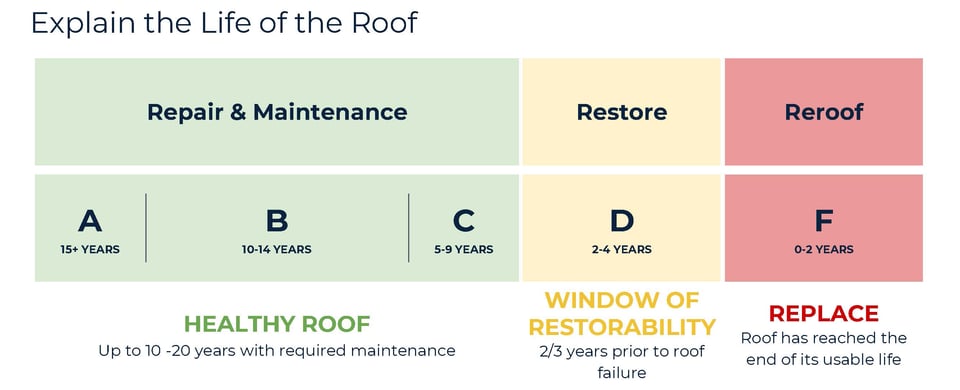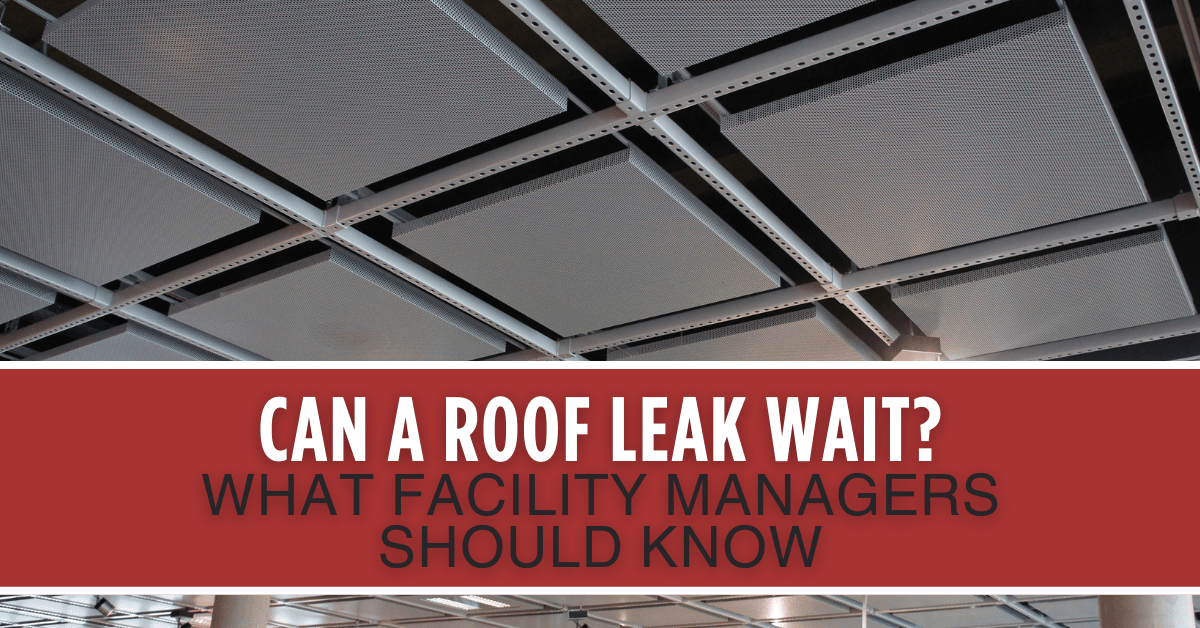5 min read
What Is a Roof Grading System? A Guide for Property Managers
Caitlin Vegas
:
Oct 24, 2025 11:07:02 AM
.png)
How can you assess the condition of a roof without relying solely on a contractor’s word? When is repair enough, and when is full replacement the smarter move?
Unclear roof conditions create budget risks, operational disruptions, and unexpected costs. For a property manager, those surprises can make you feel like you’re always playing catch-up.
A professional grading system provides objective insight into a roof’s age and life expectancy. This allows commercial property and facility managers to plan budgets and avoid reactive repairs.
At Equity Commercial Roofing, we’ve performed roof grading assessments for hundreds of buildings in Central PA. We believe this grading system should be the industry standard to provide every decision-maker with clear and transparent information.
In this guide, you’ll learn how roof grading works, what affects your grade, and how to use the results to protect your assets and plan ahead.
Clickable Table of Contents
- What Is a Roof Grading System?
- Is There an Industry Standard for Roof Grading?
- What Factors Affect a Roof's Grade?
- Why Did My Roof Receive a Low Grade?
- How is a Professional Roof Grade Evaluated?
- How to Schedule a Professional Roof Grading Inspection
What Is a Roof Grading System?
A roof grading system is a method used to determine the overall condition and restorability of a roof. Think of it as a report card for your roof that shows how well it's performing and whether it needs repairs or replacement soon.
The grading system helps property owners understand exactly where their roof stands. It provides clear guidelines for repairs, replacements, or property purchases. A low grade, for example, may mean that your roof will soon be denied coverage by your insurance.

Is There an Industry Standard for Roof Grading?
Most roofing professionals use a letter-based grading scale from A to F, similar to school grades. However, there isn't one universal standard that everyone follows. Inspection companies may have slightly different criteria for what qualifies as each grade.
Some inspectors are more strict than others when it comes to identifying problems. Best practice is to be thorough. If your contractor finds any deficiency during an inspection, it should be documented and factored into the grade. This approach helps ensure property owners get an accurate picture of their roof's condition.
The lack of a universal standard means it's important to work with a reputable roofing company. Look for one that explains its grading criteria and provides detailed documentation of its findings.
What Factors Affect a Roof's Grade?
The most obvious factor in roof grading is the current condition and age of the roofing system. Even a well-maintained roof will naturally move down the grading scale over time due to normal wear and exposure to the elements.
Roof Grading System Breakdown
| Grade | Typical Condition | Notes |
| A | Excellent condition, no deficiencies, tight seams, intact flashings | Highest grade, minimal or no issues |
| B | Minimal wear, close to perfect | Still strong, may need minor attention |
| C | Noticeable issues (open seams, flashings starting to separate) | Problems are emerging |
| D | Significant deficiencies, nearing end of service life | Last stage where restoration makes sense |
| F | Extensive damage, beyond repair | Replacement required |
Making the right choice between repair and replacement depends on the roof's current grade, the cost of necessary repairs, and how much additional life you can realistically expect from the existing system.
Why Did My Roof Receive a Low Grade?
A roof will likely receive a low grade if there are failure issues, signs of deterioration, or visible signs of poor installation.
Common Quality Issues by Roof Type
| Roof Type | Common Issues Lowering Grade |
| Metal Roofs | Loose/missing screws, rust/corrosion, failed caulking around seams/flashings |
| Shingle Roofs | Poor flashing, thin drip edges, granule loss, brittle/dried shingles |
| Flat Roofs | Thin membranes prone to punctures, failed seams, bridging pulling from walls, edge metal separation/cracking |
Installation Quality Matters
Even high-end materials won't save a roof if the installation is poor. The quality of workmanship during installation has a major impact on the final grade, sometimes more than the materials themselves. This is one reason why labor has a significant impact on your roof cost.
Common installation issues that affect grading include:
- Using inferior fasteners or screws with thinner shanks
- Installing lightweight flashing materials or drip edges
- Poor sealing around penetrations
- Inadequate membrane thickness on flat roofs
Poor installation means the roof will move up or down the grading scale much faster than it should, leading to premature repairs or replacement.
How is a Professional Roof Grade Evaluated?
Professional roof grading follows a systematic process to ensure nothing gets missed. Here's how a typical inspection unfolds:
Step 1: Perimeter Inspection
The inspection begins with a walk around the roof's perimeter. This involves checking all edge metals to make sure they're secure and haven't separated from the roof structure. On rubber roofs, this step often reveals cracks where the edge metals join together (a common problem area).
Step 2: Full Roof Survey
Next, the inspector walks the entire roof in a zigzag pattern. This methodical approach ensures complete coverage of the roof surface. During this step, they're looking for puncture marks, open seams, and any areas where the roofing material has been damaged or is starting to fail.
Step 3: Penetration and Flashing Check
The final step focuses on all roof penetrations: vents, HVAC equipment, skylights, and other items that go through the roof. All flashings around these penetrations get checked to ensure they're still properly sealed and haven't started to come apart.
For flat roofs, inspectors also look for bridging material issues. This happens where the roof membrane stretches from the horizontal roof surface to the vertical walls. The material expands and contracts with temperature changes, and over time, it can start pulling away from the wall.
Step 4: Tools and Documentation
Roof inspectors use basic tools that work well. Taking pictures is very important to show what the roof looks like and make reports. For flat roofs, inspectors use a special tool called a probe. This tool has a bent tip that helps them check if the seams are tight and find spots where the roof covering might be pulling apart.
After the inspection, you get a report with photos documenting everything the inspector found. The report also gives the roof an overall grade, like a report card.
It’s best practice to have your commercial roof inspected twice a year—once in spring and once in fall—to catch seasonal damage early, according to Travelers Insurance.
What is the Benefit of Getting Your Roof Graded?
Businesses may find that getting their roof graded provides them with lower insurance premiums and a stronger case for selling a property at its listing price.
For Real Estate Transactions
Roof grading plays a crucial role in property sales and purchases. Having records showing regular inspections and maintenance proves the roof has been cared for. Any deficiencies or developing problems have been caught and addressed in a timely manner.
When buying a commercial building, many investors request roof inspections as part of their due diligence. A poor roof grade can kill a deal entirely or become a major negotiating point for reducing the purchase price.
Property owners sometimes use detailed inspection reports during price negotiations, showing exactly what roof work will be needed and what it will cost. This documentation provides concrete evidence to support requests for price reductions.
For Insurance and Warranties
Not all insurance companies currently factor roof grades into their policies. Still, documentation of maintenance and roof condition can help claims or policy negotiations.
Warranty eligibility often depends on proper maintenance. Many roofing warranties require regular inspections and prompt attention to minor issues. A well-documented history of roof grading and maintenance helps ensure warranty coverage remains valid.
Some manufacturers may extend warranty coverage or provide additional benefits for roofs that receive regular professional attention and maintain good grades over time.
How to Schedule a Professional Roof Grading Inspection
You now have a clear understanding of what a roof grading system is and how it’s used to assess the condition and lifespan of a commercial roof. Whether you're managing one building or an entire portfolio, this system removes the guesswork and provides actionable data to guide repair, replacement, and capital planning decisions.
Roof grading puts you back in control of your building’s maintenance. With a documented grade, photos, and a detailed report, you can plan proactively, protect your assets, and avoid costly surprises.
If you’re wondering what roof repairs or replacement might cost after grading, your next step is to review the Commercial Roof Cost Guide. This article breaks down typical costs for repairs, restorations, and replacements, so you can start budgeting with accurate figures and clear expectations.
At Equity Commercial Roofing, we’ve helped hundreds of facility managers and property owners across Central PA make smarter roofing decisions. Still have questions? We're happy to help: just reach out to our team.
 Read More
Read More
.png) Read More
Read More


.png)